MENUMENU
BOOK TICKETS
DISCOUNTED ONLINE PRICE



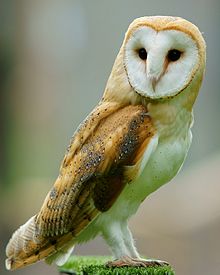

Wikipedia
The barn owl (Tyto alba) is the most widely distributed species of owl and one of the most widespread of all birds. It is also referred to as the common barn owl, to distinguish it from other species in its family, Tytonidae, which forms one of the two main lineages of living owls, the other being the typical owls (Strigidae). The barn owl is found almost everywhere in the world except polar and desert regions, Asia north of the Himalayas, most of Indonesia, and some Pacific islands.
Phylogenetic evidence shows that there are at least three major lineages of barn owl, one in Europe, western Asia and Africa, one in southeast Asia and Australasia, and one in the Americas, and some highly divergent taxa on islands. Accordingly some authorities split the group into the western barn owl for the group in Europe, western Asia and Africa, the American barn owl for the group in the Americas, and the eastern barn owl for the group in southeast Asia and Australasia. Some taxonomic authorities further split the group, recognising up to five species, and further research needs to be done to clarify the position. There is a considerable variation between the sizes and colour of the approximately 28 subspecies but most are between 33 and 39 cm (13 and 15 in) in length with wingspans ranging from 80 to 95 cm (31 to 37 in). The plumage on head and back is a mottled shade of grey or brown, the underparts vary from white to brown and are sometimes speckled with dark markings. The face is characteristically heart-shaped and is white in most subspecies. This owl does not hoot, but utters an eerie, drawn-out shriek.
The barn owl is nocturnal over most of its range, but in Britain and some Pacific islands, it also hunts by day. Barn owls specialise in hunting animals on the ground and nearly all of their food consists of small mammals which they locate by sound, their hearing being very acute. They mate for life unless one of the pair gets killed, when a new pair bond may be formed. Breeding takes place at varying times of year according to locality, with a clutch, averaging about four eggs, being laid in a nest in a hollow tree, old building or fissure in a cliff. The female does all the incubation, and she and the young chicks are reliant on the male for food. When large numbers of small prey are readily available, barn owl populations can expand rapidly, and globally the bird is considered to be of least conservation concern. Some subspecies with restricted ranges are more threatened. [Credit: Wikipedia]
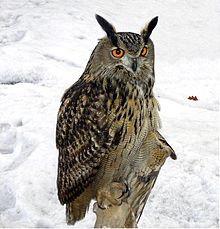

Wikipedia
The Eurasian eagle-owl (Bubo bubo) is a species of eagle-owl that resides in much of Eurasia. It is also called the European eagle-owl and in Europe, it is occasionally abbreviated to just eagle-owl. It is one of the largest species of owl, and females can grow to a total length of 75 cm (30 in), with a wingspan of 188 cm (6 ft 2 in), males being slightly smaller. This bird has distinctive ear tufts, with upper parts that are mottled with darker blackish colouring and tawny. The wings and tail are barred. The underparts are a variably hued buff, streaked with darker colour. The facial disc is poorly developed and the orange eyes are distinctive. [Credit: Wikipedia]
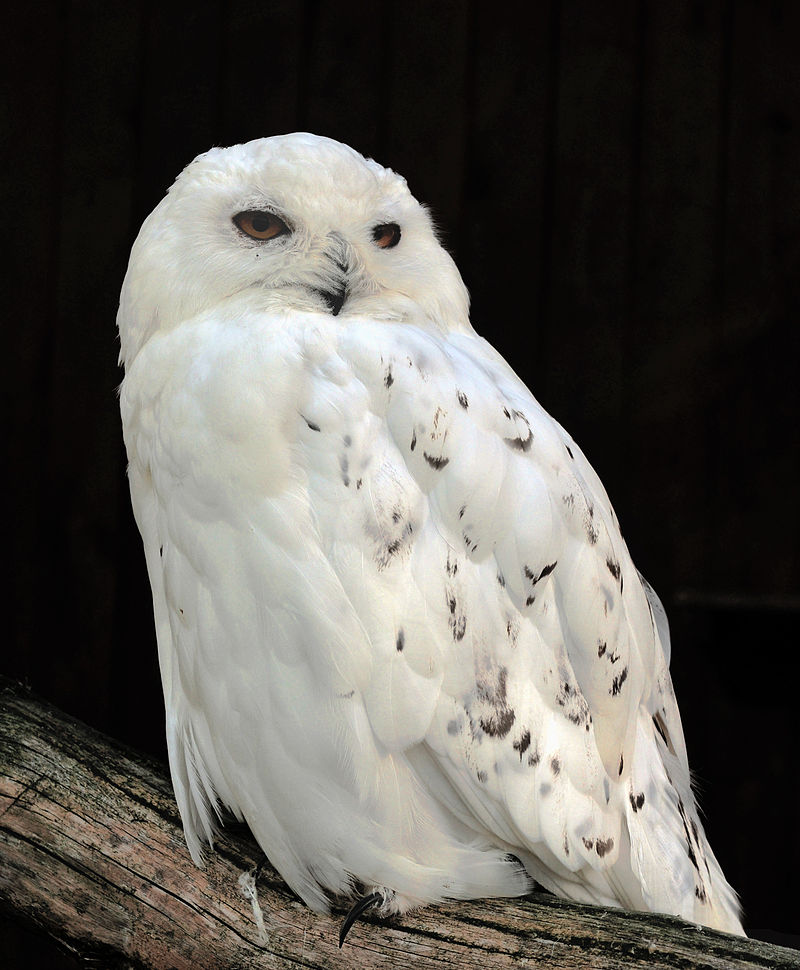

Wikipedia
The snowy owl (Bubo scandiacus) is a large, white owl of the typical owl family. Snowy owls are native to Arctic regions in North America and Eurasia. Males are almost all white, while females have more flecks of black plumage. Juvenile snowy owls have black feathers until they turn white. The snowy owl is a ground nester that primarily hunts rodents and waterfowl, and opportunistically eats carrion. Most owls sleep during the day and hunt at night, but the snowy owl is active during the day, especially in the summertime. [Source: Wikipedia]


Image Source © Wikipedia
The great horned owl is generally colored for camouflage. The underparts of the species are usually light with some brown horizontal barring; the upper parts and upper wings are generally a mottled brown usually bearing heavy, complex darker markings. All subspecies are darkly barred to some extent along the sides as well. There is a variable sized white patch on the throat.
The white throat may continue as a streak running down the middle of the breast even when the birds are not displaying, which in particularly pale individuals can widen at the belly into a large white area. South American horned owls typically have a smaller white throat patch, often unseen unless actively displaying, and rarely display the white area on the chest. [credits: Wikipedia]
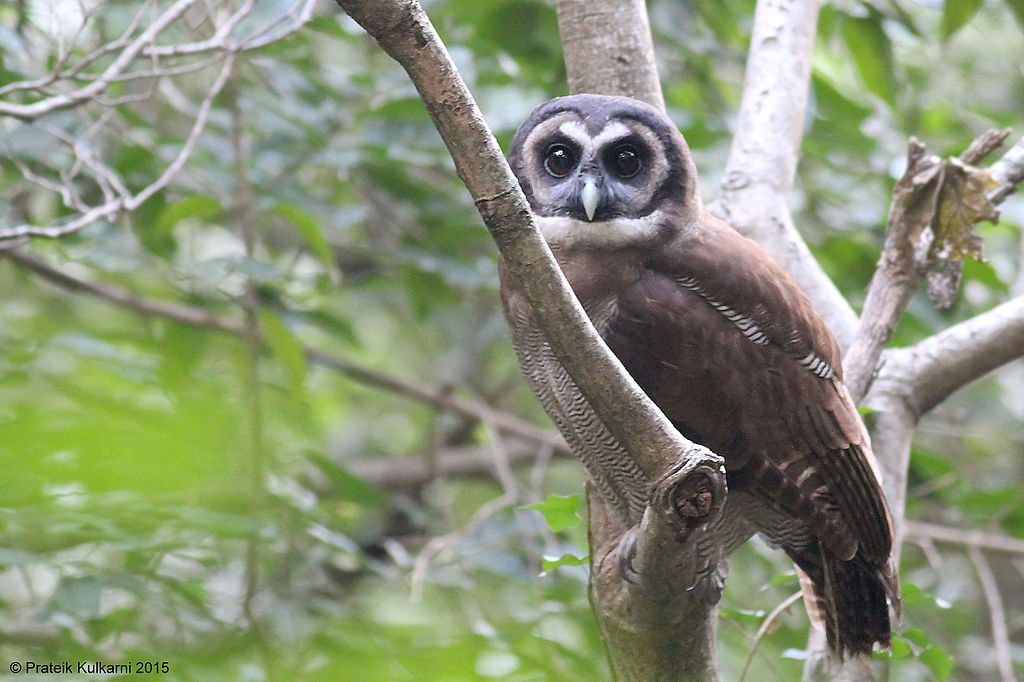

Wikipedia
The brown wood owl (Strix leptogrammica) is an owl which is a resident breeder in south Asia from India, Bangladesh and Sri Lanka east to western Indonesia and south China. This species is a part of the family of owls known as typical owls (Strigidae), which contains most species of owl. It belongs to the earless owl genus Strix.
The brown wood owl is medium large (45–57 cm), with upperparts uniformly dark brown, with faint white spotting on the shoulders. The underparts are buff with brown streaking. The facial disc is brown or rufous, edged with white and without concentric barring, and the eyes are dark brown. There is a white neckband. The sexes are similar. [Credit: Wikipedia]
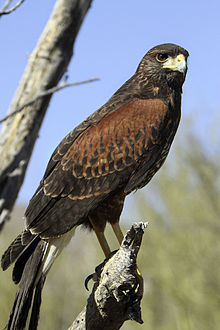

Wikipedia
The Harris’s hawk (Parabuteo unicinctus) formerly known as the bay-winged hawk or dusky hawk, is a medium-large bird of prey that breeds from the southwestern United States south to Chile, central Argentina, and Brazil. Birds are sometimes reported at large in Western Europe, especially Britain, but it is a popular species in falconry and these records almost certainly all refer to escapes from captivity.
The name is derived from the Greek para, meaning beside, near or like, and the Latin buteo, referring to a kind of buzzard; uni meaning once; and cinctus meaning girdled, referring to the white band at the tip of the tail. John James Audubon gave this bird its English name in honor of his ornithological companion, financial supporter, and friend Edward Harris.
The Harris’s hawk is notable for its behaviour of hunting cooperatively in packs consisting of tolerant groups, while other raptors often hunt alone. Harris hawks’ social nature has been attributed to their intelligence, which makes them easy to train and have made them a popular bird for use in falconry. [Credit: Wikipedia]
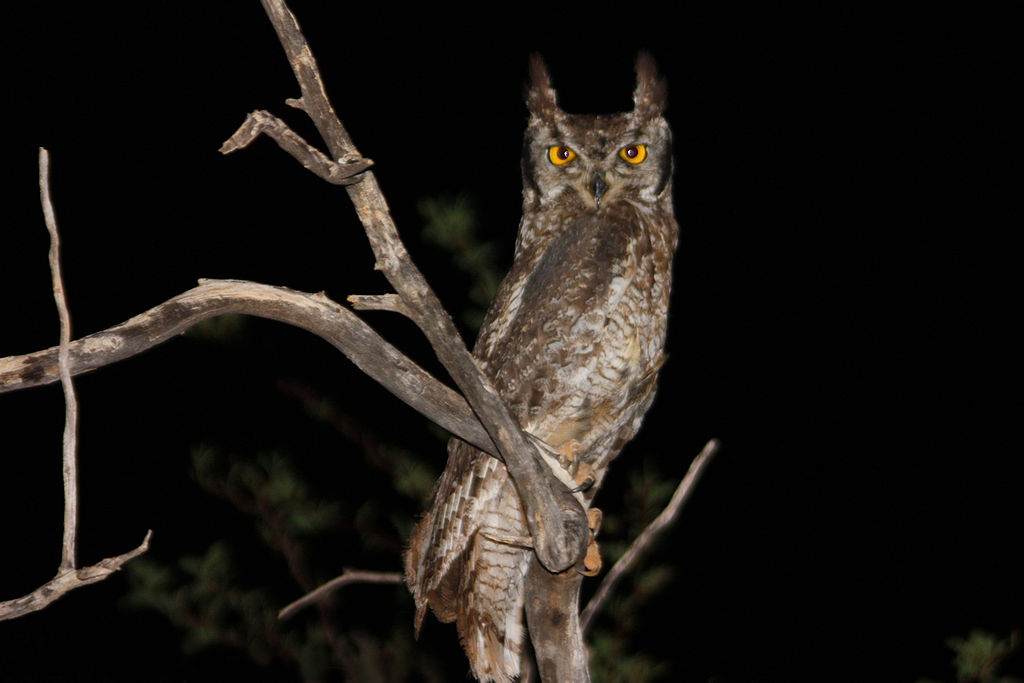

Image source © Wikipedia
The spotted eagle-owl (Bubo africanus) is a medium-sized species of owl, one of the smallest of the eagle owls. Its length is 45 centimetres (18 in) and its weight is from 480 to 850 grams (1.1 to 1.9 lb). It has a 100 to 140 centimetres (39 to 55 in) wingspan. The facial disk is off white to pale ochre and the eyes are yellow. It has prominent ear tufts, and the upper body is dusky brown, the lower parts off-white with brown bars. Prior to 1999 the spotted eagle-owl was considered conspecific with the greyish eagle-owl, but now it is classed as a separate species. [credits: Wikipedia]
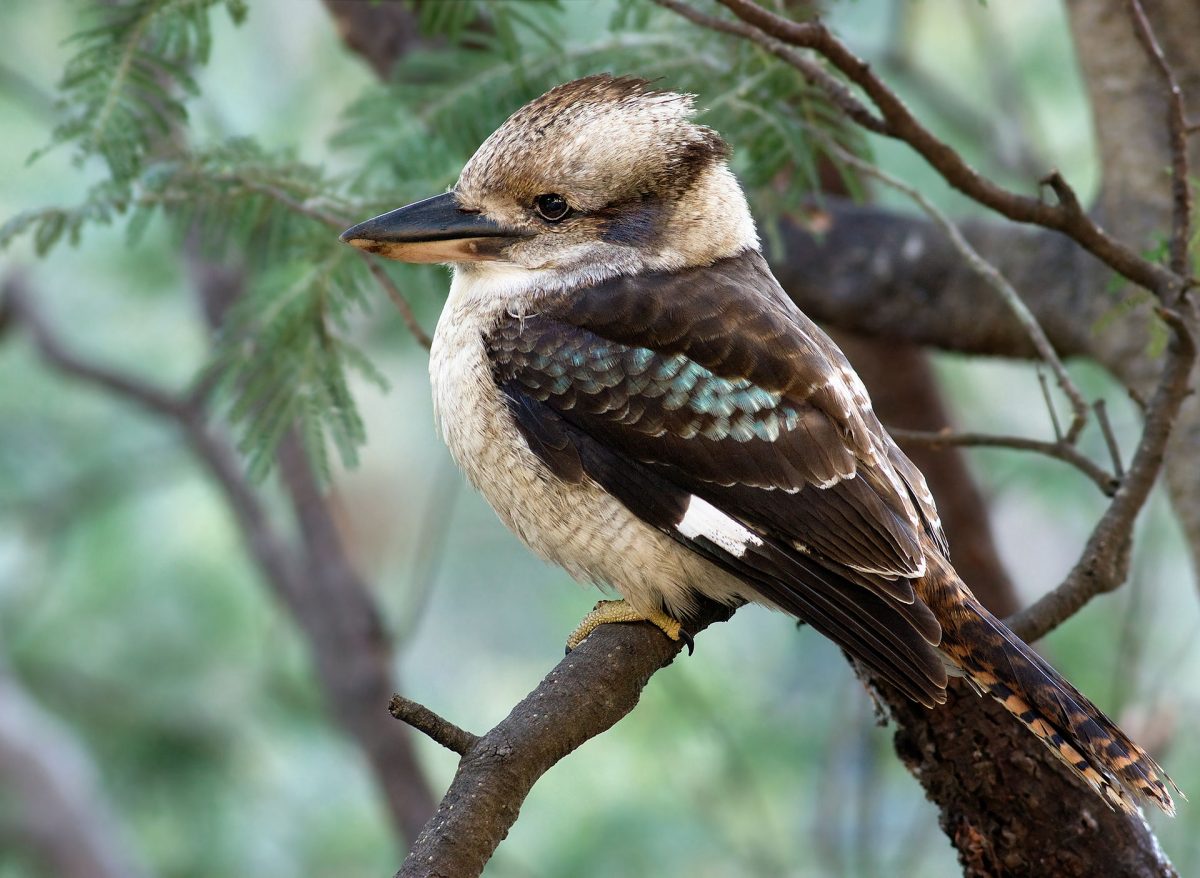

Wikipedia
Kookaburras are terrestrial tree kingfishers of the genus Dacelo native to Australia and New Guinea, which grow to between 28–42 cm (11–17 in) in length. The name is a loanword from Wiradjuri guuguubarra, onomatopoeic of its call. The loud distinctive call of the laughing kookaburra is widely used as a stock sound effect in situations that involve an Australian bush setting or tropical jungle, especially in older movies.
They are found in habitats ranging from humid forest to arid savanna, as well as in suburban areas with tall trees or near running water. Even though they belong to the larger group known as “kingfishers”, kookaburras are not closely associated with water. [Credit: Wikipedia]
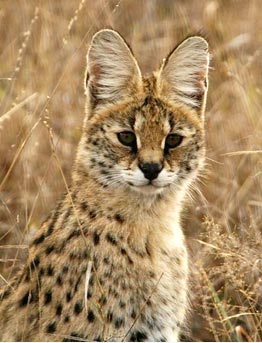

Image source © Wikipedia
The serval /ˈsɜːrvəl/ (Leptailurus serval), also known as the tierboskat, is a wild cat found in Africa. The sole member of the genus Leptailurus, it was first described by German naturalist Johann Christian Daniel von Schreber in 1776. Eighteen subspecies are recognised. The serval is a slender, medium-sized cat that stands 54–62 centimetres (21–24 in) at the shoulder and weighs 8–18 kilograms (18–40 lb). It is characterised by a small head, large ears, a golden-yellow to buff coat spotted and striped with black, and a short, black-tipped tail. The serval has the longest legs of any cat relative to its body size. [credits: Wikipedia]
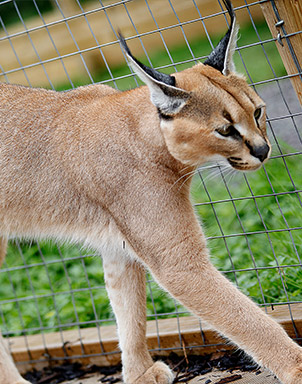

Image source © Hoo Farm
The caracal is a medium-sized wild cat that lives in Africa, the Middle East, Persia and the Indian subcontinent. It reaches 40–50 centimetres (16–20 in) at the shoulder, and weighs 8–18 kilograms (18–40 lb). The coat is uniformly reddish tan or sandy, while the ventral parts are lighter with small reddish markings. The caracal is characterised by a robust build, long legs, a short face, long tufted ears, and long canine teeth. It was first described by German naturalist Johann Christian Daniel von Schreber in 1777. Eight subspecies are recognised. [credits: Wikipedia]
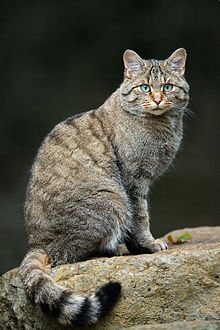

Wikipedia
The European wildcat (Felis silvestris silvestris) is the nominate subspecies of the wildcat that inhabits forests of Western, Southern, Central and Eastern Europe up to the Caucasus Mountains. It is absent in Scandinavia and has been extirpated in England and Wales.
In France and Italy, the European wildcat is predominantly nocturnal, but also active in the daytime when undisturbed by human activities. [Credit: Wikipedia]
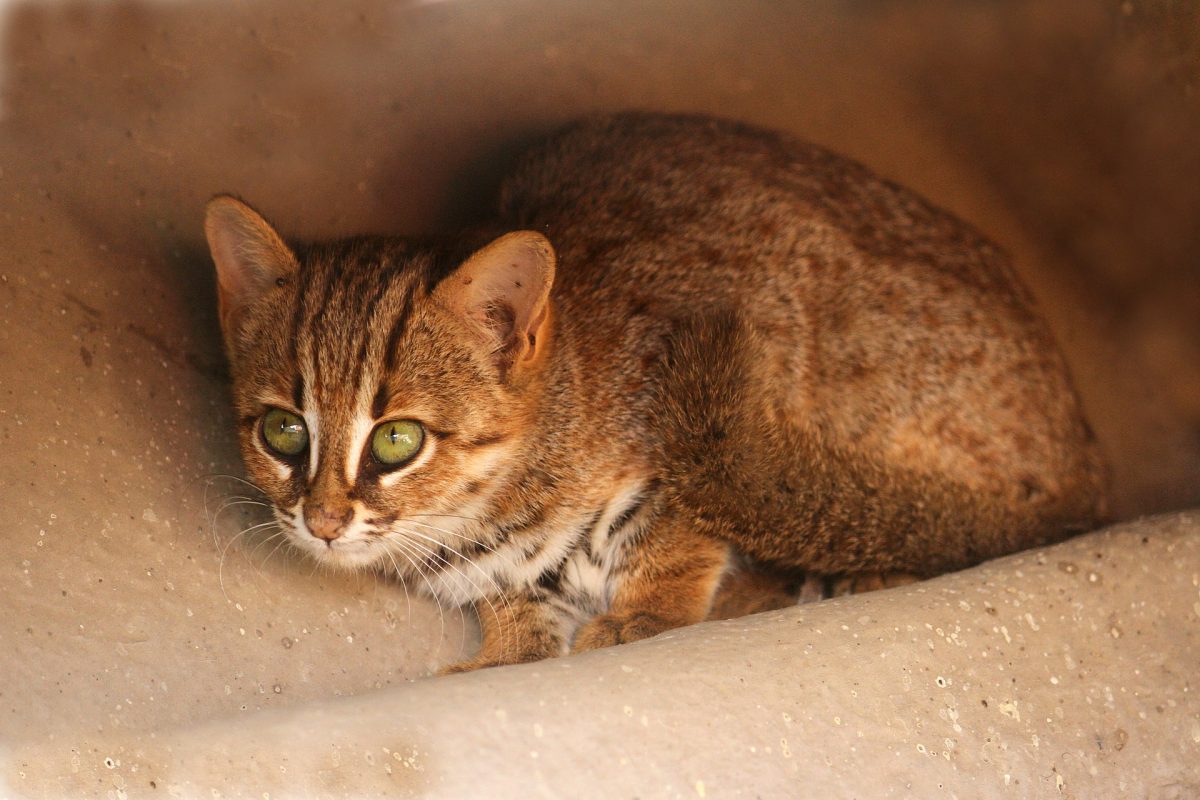

Wikipedia
The rusty-spotted cat (Prionailurus rubiginosus) is one of the cat family’s smallest members, of which historical records are known only from India and Sri Lanka. In 2012, it was also recorded in the western Terai of Nepal. Since 2016, the global wild population is listed as Near Threatened on the IUCN Red List as it is fragmented and affected by loss and destruction of prime habitat, deciduous forests. [Credit: Wikipedia]
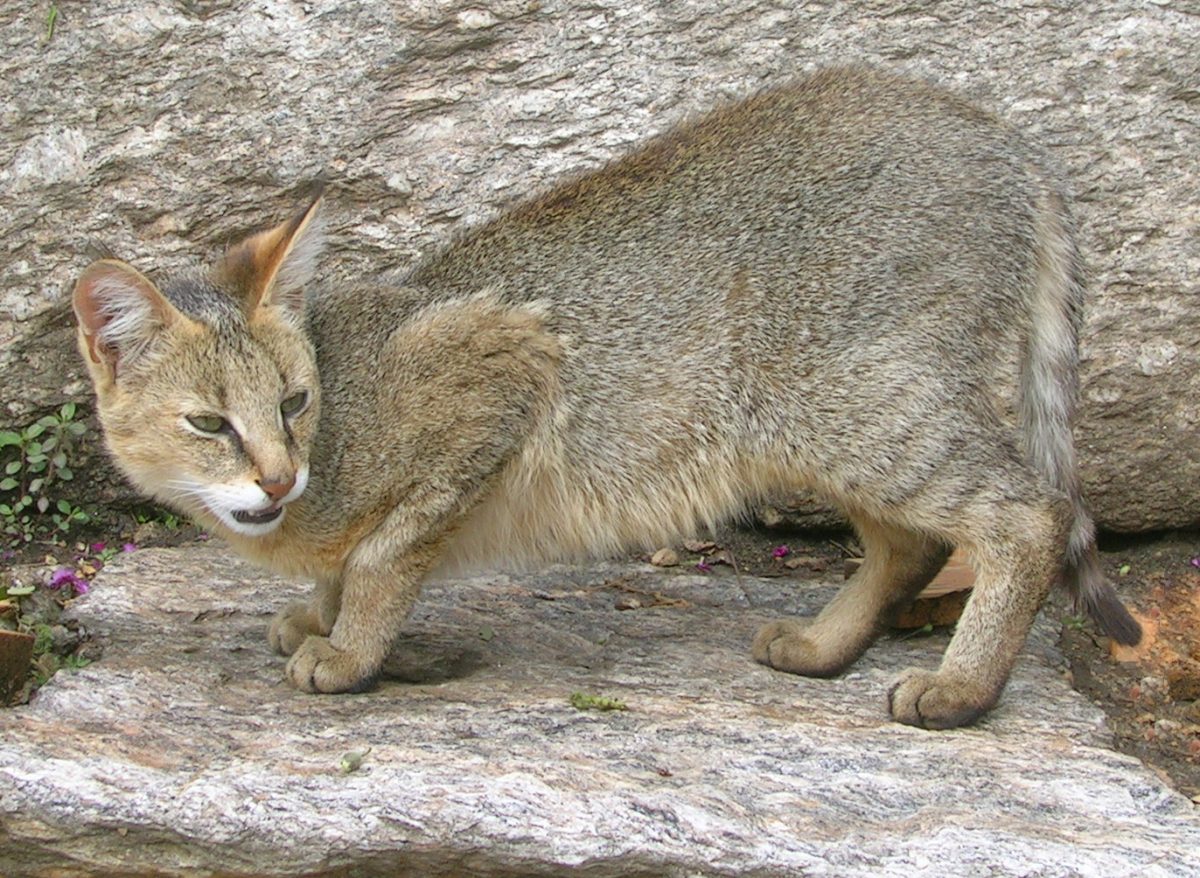

Wikipedia
The jungle cat (Felis chaus), also called reed cat and swamp cat, is a medium-sized cat native to the Middle East, South and Southeast Asia and southern China. It inhabits foremost wetlands like swamps, littoral and riparian areas with dense vegetation. It is listed as Least Concern on the IUCN Red List, and is mainly threatened by destruction of wetlands, trapping and poisoning. [Credit: Wikipedia]
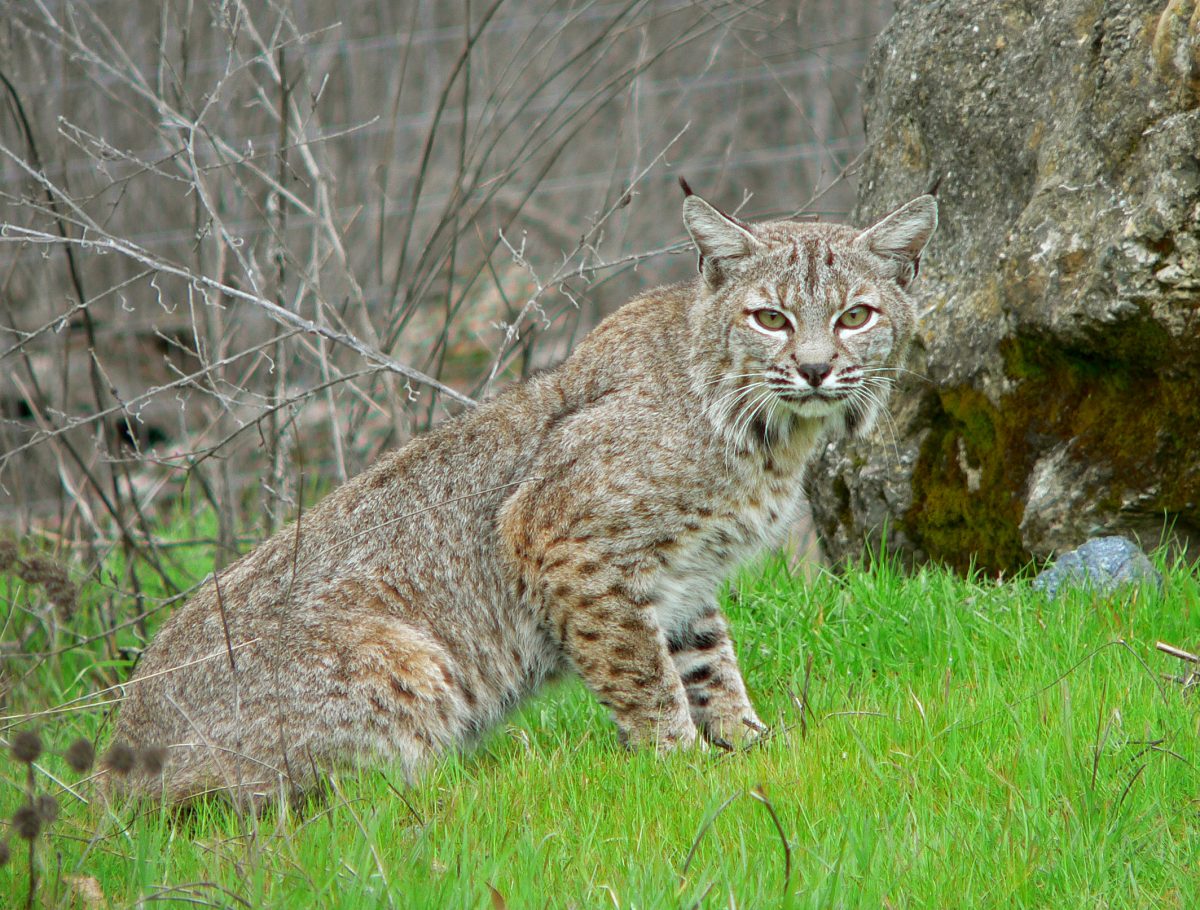

Wikipedia
The bobcat (Lynx rufus) is a medium-sized North American cat that first appeared during the Irvingtonian stage around 1.8 million years ago (AEO). Containing two recognized subspecies, it ranges from southern Canada to central Mexico, including most of the contiguous United States. The bobcat is an adaptable predator that inhabits wooded areas, as well as semidesert, urban edge, forest edge, and swampland environments. It remains in some of its original range, but populations are vulnerable to local extinction (“extirpation”) by coyotes and domestic animals. With a gray to brown coat, whiskered face, and black-tufted ears, the bobcat resembles the other species of the midsized genus Lynx. It is smaller on average than the Canada lynx, with which it shares parts of its range, but is about twice as large as the domestic cat. It has distinctive black bars on its forelegs and a black-tipped, stubby (or “bobbed”) tail, from which it derives its name.[Credit: Wikipedia]
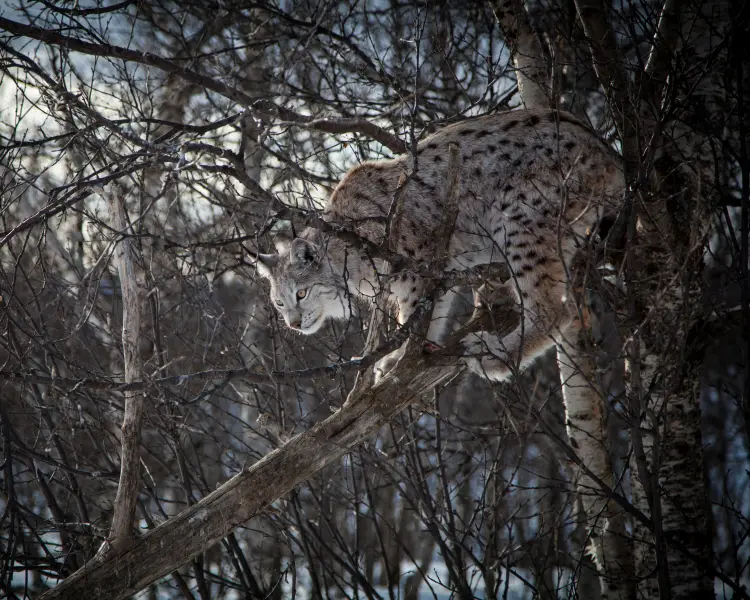

Animalia
The Eurasian lynx is Europe’s third-largest predator after brown bears and wolves and is the biggest of the species of lynx. Its body is short and it has long legs with large feet. Its ears have a distinctive black tuft at its tip and its paws have retractile sharp claws. Its coat is long and very dense, especially during the winter, and has a wider range of colors than the other cats. Its shorter, summer coat is more brownish or reddish, while in winter it may be yellowish-gray, silver-gray, grizzled grayish-brown, dark gray, or ashy blue. The pattern on the coat also varies a lot, with some animals having very clear black spots, which sometimes become narrow stripes, others having almost no spots. [SOURCE: ANIMALIA]
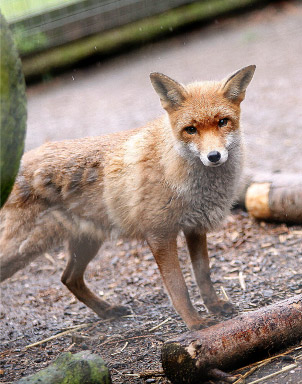

Image source © Hoo Farm
The red fox (Vulpes vulpes) is the largest of the true foxes and the most abundant wild member of the Carnivora, being present across the entire Northern Hemisphere from the Arctic Circle to North Africa, North America and Eurasia. It is listed as least concern by the IUCN.
Its range has increased alongside human expansion, having been introduced to Australia, where it is considered harmful to native mammals and bird populations. Due to its presence in Australia, it is included among the list of the “world’s 100 worst invasive species”. [credits: Wikipedia]
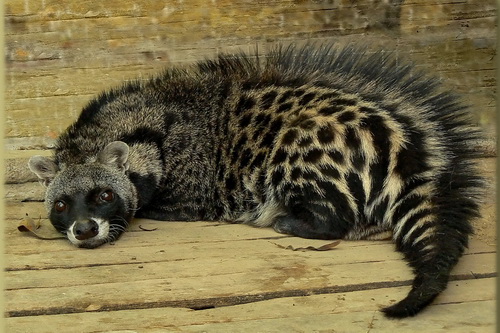

Wikipedia
The African civet (Civettictis civetta) is the largest representative of the African Viverridae and the sole member of its genus. It is considered common and widely distributed in sub-Saharan Africa.
It is primarily nocturnal and spends the day sleeping in dense vegetation. The mammal is awake at sunset. It is a solitary mammal that has a unique coloration: the black and white stripes and blotches covering the coarse pelage of the animal are extremely variable and allow it to be cryptic. The black bands surrounding its eyes closely resemble those of the raccoon. Other distinguishing features are its disproportionately large hindquarters and its erectile dorsal crest.
The African civet is an omnivorous generalist, taking small vertebrates, invertebrates, eggs, carrion, and vegetable matter. It is capable of taking on poisonous invertebrates and snakes. Prey is primarily detected by smell and sound rather than by sight. It prefers riverine habitats and woodlands.
Like all civets it has perineal glands that produce a fluid known as civet, which it spreads on markers in its territory to claim its range. It is used in the perfume industry. [Credit: Wikipedia]
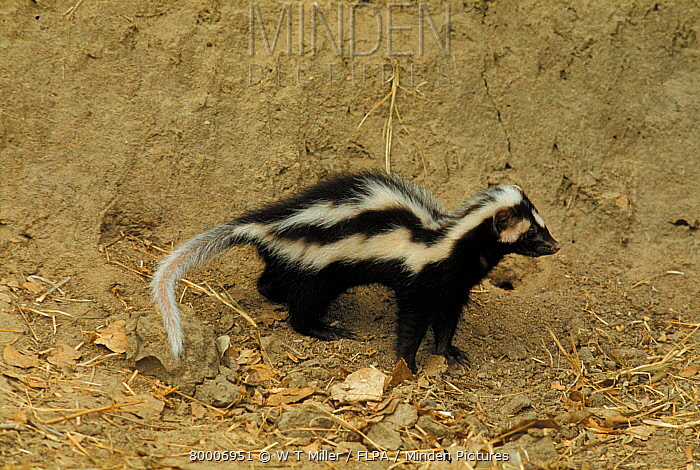

Minden Pictures
The striped polecat (Ictonyx striatus) – also called the African polecat, zoril, zorille, zorilla, Cape polecat, and African skunk – is a member of the family Mustelidae that resembles a skunk (of the family Mephitidae). The name “zorilla” comes from the word “zorro”, which in Spanish means “fox”. It lives predominantly in dry and arid climates, such as the savannahs and open country of Central, Southern, and sub-Saharan Africa, excluding the Congo basin and the more coastal areas of West Africa. [Credit: Wikipedia]


Image source © Wikipedia
he meerkat is a small carnivoran belonging to the mongoose family (Herpestidae). It is the only member of the genus Suricata. Meerkats live in all parts of the Kalahari Desert in Botswana, in much of the Namib Desert in Namibia and southwestern Angola, and in South Africa. A group of meerkats is called a “mob”, “gang” or “clan”. A meerkat clan often contains about 20 meerkats, but some super-families have 50 or more members. In captivity, meerkats have an average life span of 12–14 years, and about half this in the wild. [credits: Wikipedia]
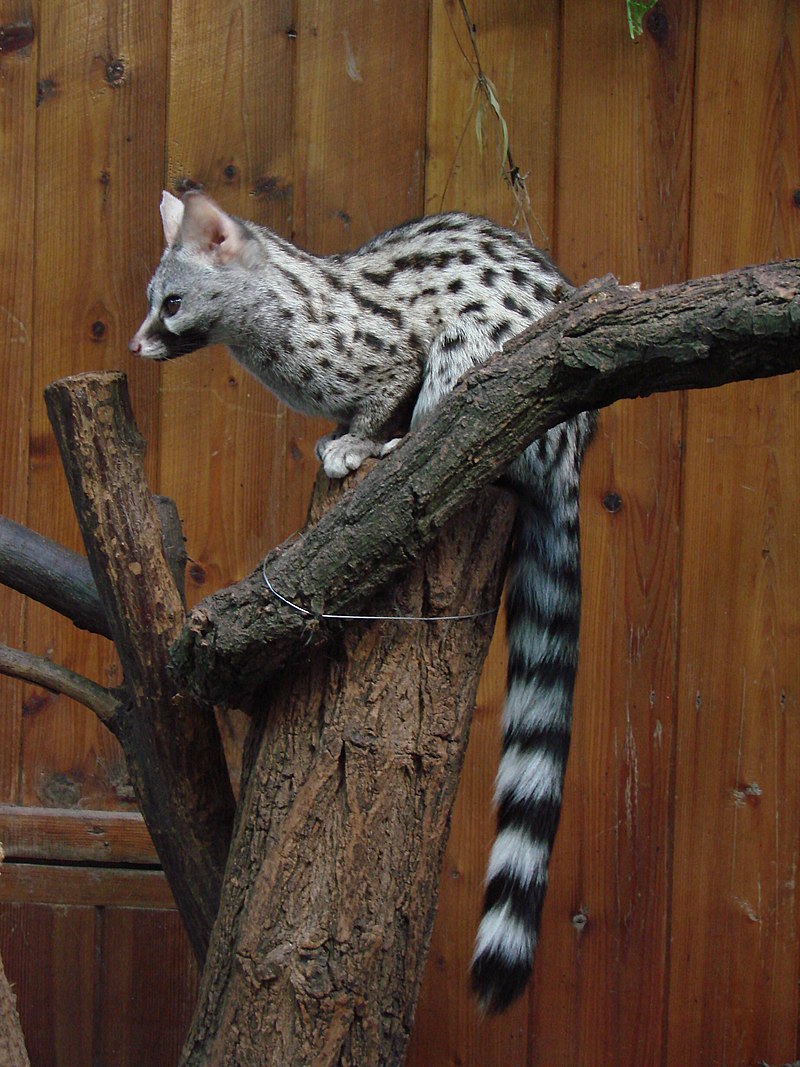

Wikipedia
The common genet (Genetta genetta) is a small viverrid indigenous to Africa that was introduced to southwestern Europe and the Balearic Islands. As it is widely distributed north of the Sahara, in savanna zones south of the Sahara to southern Africa and along the coast of Arabia, Yemen and Oman, it is listed as Least Concern on the IUCN Red List. It has also been recorded in Germany, Belgium and Switzerland. [Credit: Wikipedia]
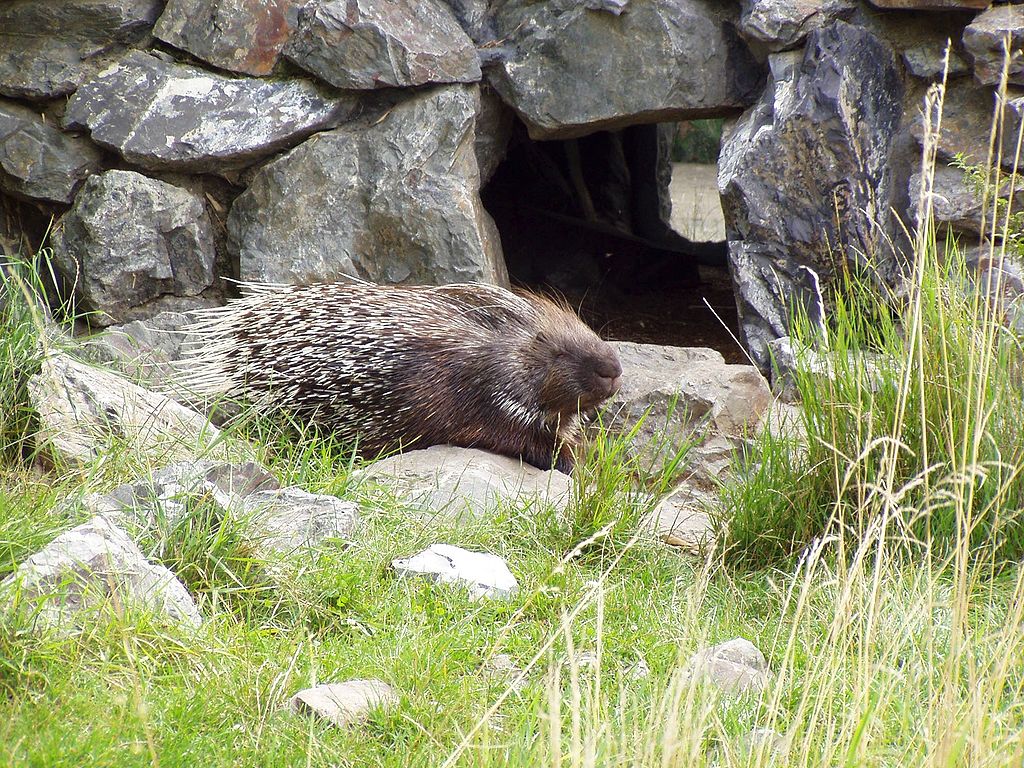

Wikipedia
The Indian crested porcupine is a large rodent, weighing 11–18 kg. Their body (from the nose to the base of the tail) measures between 70–90 cm, with the tail adding an additional 8–10 cm. The lifespan of wild Indian crested porcupines is unknown, but the oldest known captive individual was a female that lived to be 27.1 years old.
It is covered in multiple layers of modified hair called quills, with longer, thinner quills covering a layer of shorter, thicker ones. The quills are brown or black with alternating white and black bands. They are made of keratin and are relatively flexible. Each quill is connected to a muscle at its base, allowing the porcupine to raise its quills when it feels threatened. The longest quills are located on the neck and shoulder, where the quills form a “skirt” around the animal. These quills can grow up to 51 cm (20 in) long, with most measuring between 15–30 cm. Smaller (20 cm) and more rigid quills are packed densely on the back and rump. These smaller quills are used to stab at potential threats. The base of the tail contains shorter quills that appear white in color, with longer, hollow quills that the porcupine can rattle to produce a warning sound when threatened. Contrary to popular belief, Indian crested porcupines (like all porcupines) cannot shoot their quills.
The Indian crested porcupine has a stocky build with a low surface area to volume ratio, which aids in heat conservation. It has broad feet with long claws used for burrowing. Like all porcupines, the Indian crested porcupine has a good sense of smell and sharp, chisel-like incisors. [Credit: Wikipedia]
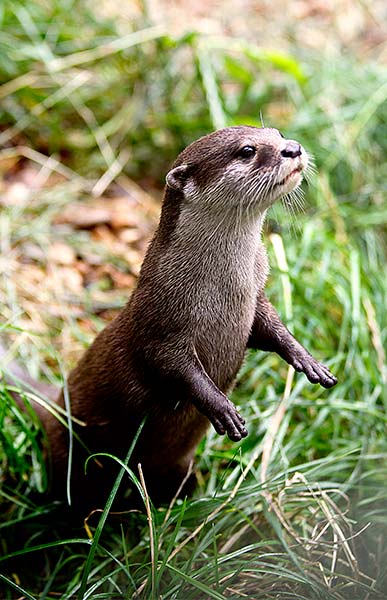

The oriental small-clawed otter (Amblonyx cinerea), also known as the Asian small-clawed otter, is the smallest otter species in the world, weighing less than 5 kg. It lives in mangrove swamps and freshwater wetlands of Bangladesh, Burma, India, southern China, Laos, Malaysia, Indonesia, Singapore, the Philippines, Thailand, and Vietnam.
Its paws are a distinctive feature, its claws not extending beyond the fleshy end pads of its partially webbed fingers and toes. This gives it a high degree of manual dexterity so that it can use its paws to feed on molluscs, crabs and other small aquatic animals. [credits: Wikipedia]